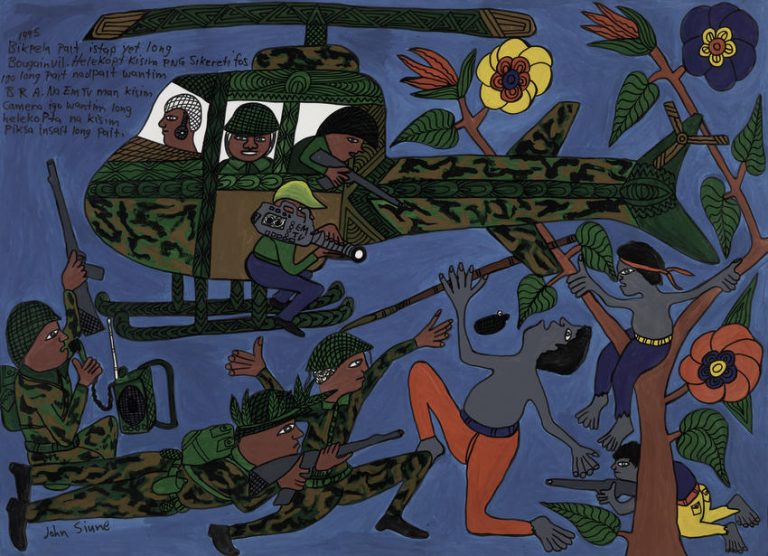We acknowledge the Traditional Owners of the land on which the Queensland Art Gallery | Gallery of Modern Art stands and recognise the creative contribution First Australians make to the art and culture of this country.

John Siune / Kuman people, Chimbu Province / Papua New Guinea 1965–2016 / Bikpela pait istap yet long Bougainvil. Helekopt kisim PNG sikereti fos 190 long pait nadpait wantim BRA. Na EMTV man kisim camera igo wantim long helekopta na kisim piksa insait long pait. (There is still a war going on in Bougainville. The helicopter is taking the PNG security force 190 to fight, against the BRA. And, the EMTV cameraman is going with them to get photos of the action as it happens.) 1995 / Synthetic polymer paint / 79 x 109cm / Purchased 1998. Queensland Art Gallery Foundation Grant / Collection: Queensland Art Gallery | Gallery of Modern Art / © John Siune
John SiuneBikpela pait istap yet long Bougainvil. Helekopt kisim PNG sikereti fos 190 long pait nadpait wantim BRA. Na EMTV man kisim camera igo wantim long helekopta na kisim piksa insait long pait. (There is still a war going on in Bougainville. The helicopter is taking the PNG security force 190 to fight, against the BRA. And, the EMTV cameraman is going with them to get photos of the action as it happens.) 1995
Not Currently on Display
John Siune’s Bikpela pait istap yet long Bougainvil (There is still a war going on in Bougainville) responds to the Papua New Guinean defence force’s use of Iroquois military helicopters, supplied by the Australian Government in the 1980s in its conflict with the BRA (Bougainville Revolutionary Army).
Ignited by local concerns over the environmental consequences of the Panguna mine and the distribution of royalties, the decade-long conflict (1988–98) claimed the lives of thousands of residents of Bougainville, together with many Papua New Guinean soldiers.
In Siune’s painting, the disparity between the two forces is emphasised as is the need for independent documentation of the conditions on the ground. Siune, in the guise of an EM TV camera man, depicts the BRA in villagers’ clothes, barefoot and largely unarmed, while their better-equipped ‘redskin’ opponents attack in force.
John Siune was born in 1965 in Kapank, a village in Papua New Guinea’s Highlands. In 1982 he moved to Port Moresby where he trained as a picture framer. In this environment he developed the idea of art as an object with commercial value and was introduced to works by senior artist from his region, Mathias Kauage.
Siune started painting in 1989 and his work was deeply influenced by Kauage and the artists working around him. Siune’s first painting of the Bougainville crisis in 1991 marked a significant turn in his art, which began to engage with contemporary and often controversial issues of PNG society.
In recent years, John Siune’s work has attracted critical acclaim and is represented in the collections of major art institutions such as the Centre Culturel Tjibaou (Noumea, New Caledonia) and the National Gallery of Australia.
Discussion Questions
1. The tree in this painting has beautiful flowers and is the most colourful part. Do you think that the artist wanted this to stand out? Why?
2. Research the Bougainville Civil War and subsequent Bougainville Peace Agreement. What do you think the meaning of this artwork is?
3. Identify the elements that Siune used to comment on the role of the media in the Bougainville conflict.
Activities
Collect multiple media sources about a current or recent conflict. Combine elements from these sources to create an artwork to prompt a response from the viewer. Can you use colour and incorporate elements of humour to highlight the tragic and absurd nature of conflict?